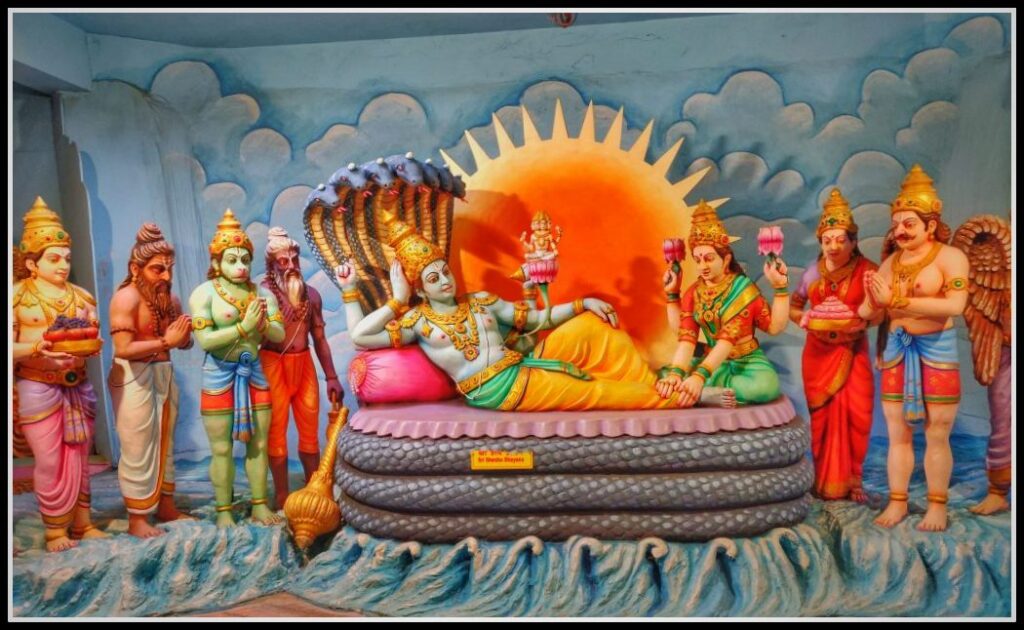
Once, the sage Durvasa encountered the demigod Indra, the king of heavens, and greeted him with a marigold garland. However, Indra, filled with pride, ignored the sage and placed the garland on his white elephant, Airavat, which promptly discarded and trampled it. Enraged, Durvasa cursed Indra to lose all his opulence. Shortly after, demons attacked and defeated the demigods, resulting in many casualties. Bali, the demon king, established dominion over the three realms. Despite the efforts of sages, they couldn’t revive the fallen demigods. Following Lord Brahma’s advice, the demigods went to the boundary of Svetadvipa, offered prayers to Lord Vishnu, and He appeared in a blinding effulgence, visible only to Brahma. Lord Vishnu suggested that the demigods and demons collaborate to churn the Milk Ocean for obtaining the nectar of immortality (amrita), with Mandara Mountain as the churning rod and the serpent Vasuki as the rope. He proposed that the demons and demigods should jointly distribute the nectar once it had been retrieved from the ocean. He warned the demigods not to be greedy for other treasures and to remain calm even if the demons claimed them. After giving these instructions, Lord Vishnu disappeared. This pastime is commonly known as Samudra Manthan, translating to the ‘churning of the ocean.’ It is occasionally referred to as Sagara Manthan, as ‘Sagara’ is synonymous with Samudra. Additionally, it goes by the name ‘Kshirasagara Manthan,’ with Kshirasagara denoting the ocean of milk that was churned in this endeavor. The intricate account of Samudra Manthan has been extensively documented in texts like the Bhagavata Purana and the Vishnu Purana. In this article, we will endeavor to provide a description of these details.
Samudra Manthan – Churning of the Milk Ocean
Lord Indra and Bali Maharaja, the demon king, agreed to a truce for the purpose of churning the ocean and sharing the resulting nectar between demigods and demons. Bali Maharaja, a disciple of Shukracharya and the grandson of Prahlada Maharaja, a devoted follower of Lord Vishnu, accepted the deal, secretly planning to take the nectar from the weakened demigods later. During the churning, some demons and demigods lost their lives while attempting to lift the Mandara mountain. Lord Vishnu revived them with His gaze and effortlessly moved the mountain near the Milk Ocean. The serpent Vasuki served as the rope, with demons holding its hood and demigods gripping its tail. However, the mountain started sinking into the ocean due to lack of support, causing frustration. To assist in the churning, Lord Sri Hari took on the form of Kurma avatar (tortoise incarnation) and lifted the massive mountain on His back, which was a hundred yojanas wide. Remarkably, the Lord hardly felt any discomfort; it was like a mere itch to Him.
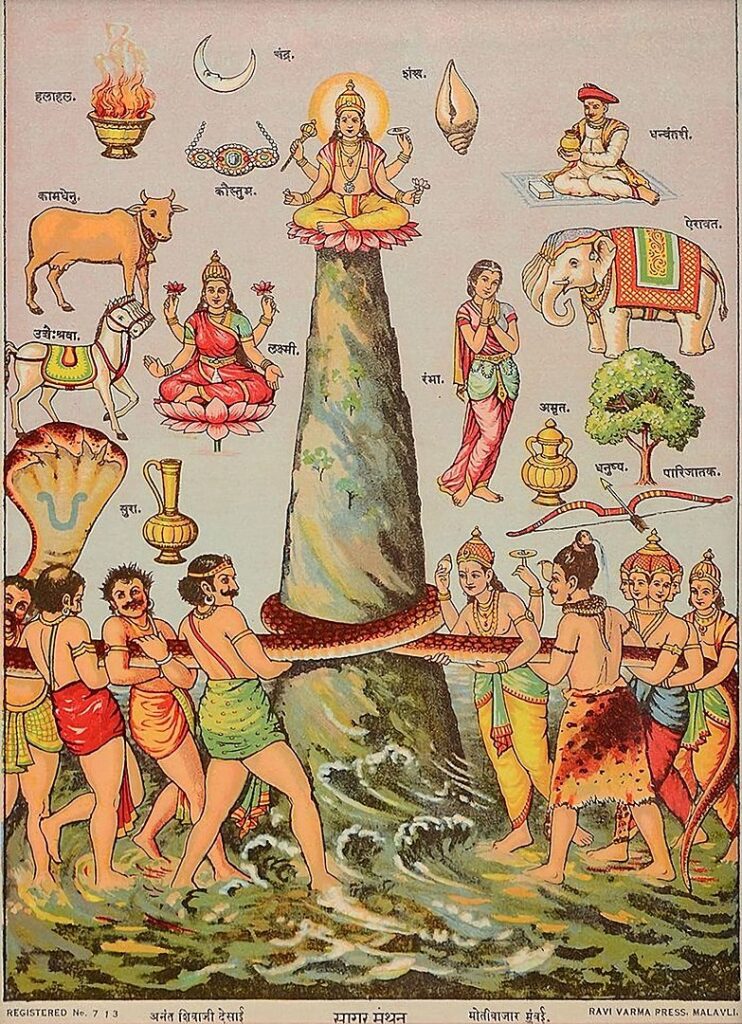
Lord Shiva saves the world by consuming Poison (Halahala)
The demigods and demons struggled to churn the Milk Ocean, but when they grew frustrated, Lord Vishnu himself took over. He appeared as a dark cloud, dressed in yellow garments with lightning-like earrings and a flower garland. With his strong, fearless arms, he held Vasuki and used Mandara Mountain as a churning rod. The ocean became turbulent, and even large aquatic creatures like whales and crocodiles surfaced.

During the churning, a deadly poison called ‘halahala’ surfaced. In response, the demigods sought refuge in Lord Shiva (Sadasiva) out of fear. Some wonder why Lord Vishnu, the Supreme Lord, didn’t directly resolve the issue. According to Srila Madhvacharya, Lord Vishnu could have but chose to credit Lord Shiva. Shiva, praised by demigods like Brahma and Indra, decided to protect the world by drinking the poison.
Seated on Mount Kailash with his wife Bhavani, Lord Shiva believed it was his duty to safeguard suffering beings. He explained that the master should protect dependents, even amid conflicts. Devotees strive to save others, pleasing Lord Hari, benefiting all creatures. Thus, Lord Shiva drank the poison, leaving a bluish mark on his neck, earning him the name “Nilkantha” or one with a bluish neck.
Scorpions, cobras, venomous creatures, and other animals prone to poisonous bites seized the chance to consume any trace of poison that had spilled from Lord Shiva’s hand as he drank.
Manifestations from the Churning: Surabhi, Uccaihsrava, Airavata, Gems, and Apsaras
After Lord Shiva bravely consumed the poison, both the demigods and demons, filled with joy, resumed churning the ocean with renewed determination. As a result, a celestial cow named Surabhi emerged. Wise sages well-versed in Vedic rituals took charge of Surabhi, who produced an abundance of yogurt, milk, and ghee, essential for sacred offerings in fire rituals. Their purpose was to obtain pure ghee for performing sacrifices that would elevate them to higher celestial realms, including Brahmaloka.
Following this, a resplendent white horse named Uccaihsrava manifested. Bali Maharaja desired to possess this horse, and Indra, the King of Heaven, didn’t object, as he had received prior guidance from the Supreme Lord.
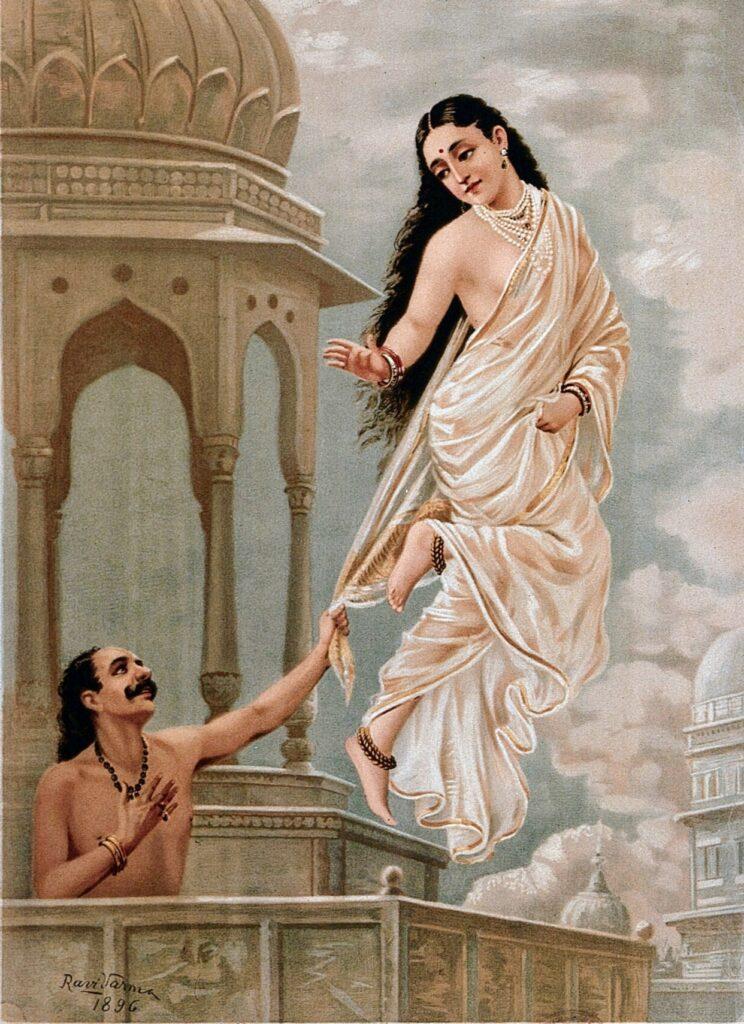
Subsequently, the king of elephants, known as Airavata, emerged. This white elephant, with its four tusks, rivaled the grandeur of Kailash Mountain, Lord Shiva’s divine abode. Following Airavata, eight mighty elephants, led by Airavana, and eight she-elephants, headed by Abhramu, were generated.
From the vast ocean, two renowned gems, the Kaustubha-mani and Padmaraga-mani, materialized. Lord Vishnu sought to adorn His chest with these precious jewels. Then, the divine parijata flower, which adorns the celestial realms, made its appearance.
Lastly, the Apsaras emerged, adorned with exquisite golden ornaments and necklaces, dressed in captivating attire. These celestial beings moved gracefully and enchantingly, captivating the denizens of heavenly worlds with their alluring charm.
The Goddess of Fortune emerges from the Ocean
Then the goddess of fortune, wholly devoted to Vishnu, emanated in a radiant form surpassing lightning’s brilliance. Her unparalleled beauty, youthful radiance, and opulent aura attracted all, including demigods, demons, and humans, as she was the source of all wealth.
Indra provided her with a fitting throne, while personified sacred rivers offered pure water in golden vessels. The land itself gathered herbs for her installation. Cows provided essential products, and spring collected seasonal offerings. Sages conducted a sacred bathing ceremony with Vedic mantras, and dancers performed graceful moves to melodious songs.
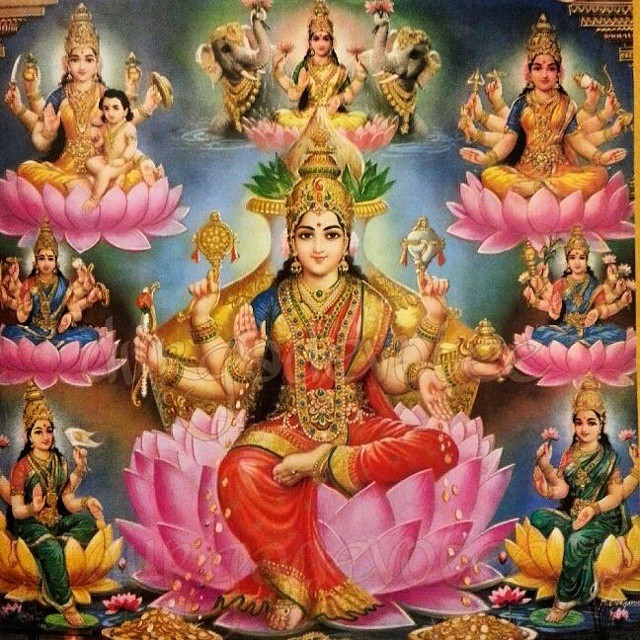
Elephants carried Ganges water for her bath, and brahmanas recited mantras. Throughout, she retained her grace, holding a lotus. The ocean contributed golden silk garments, Varuna brought flower garlands, and Visvakarma offered ornate jewelry. Sarasvati provided a necklace, Brahma a lotus, and Nagaloka residents earrings.
Having been celebrated, Mother Lakshmi moved gracefully among celestial beings. After searching for qualities and finding none devoid of flaws, she chose Vishnu as her husband. She adorned Him with a lotus garland and stood by His side, radiating shyness and a captivating smile. Vishnu, the father of the three worlds, made her reside on His bosom, for it is the abode of Mother Lakshmi, the bestower of prosperity, whose benevolent gaze can enhance the opulence of the three worlds and their inhabitants.
Dhanvantari emerges with Amrita, the nectar of Immortality
Next came Varuni, the lotus-eyed goddess associated with the control of those indulging in alcohol. With the approval of the Supreme Lord Vishnu, the demons, led by Bali Maharaja, assumed possession of Varuni.
Then, while demons and demigods were actively engaged in churning the Ocean of Milk, a remarkable male figure emerged. He possessed a robust physique, with long, sturdy arms, a neck adorned with three distinct lines resembling a conch shell, reddish eyes, and a dark complexion. He appeared youthful, adorned with garlands of flowers and an array of ornaments. His attire consisted of yellow garments, and he wore polished pearl earrings. His hair tips were oiled, and he had a broad chest, exuding alluring qualities. This stout and powerful figure carried a jug filled to the brim with nectar. This was none other than Dhanvantari, a plenary aspect of Lord Vishnu, deeply knowledgeable in the science of medicine and authorized to partake in sacrifices as one of the demigods.
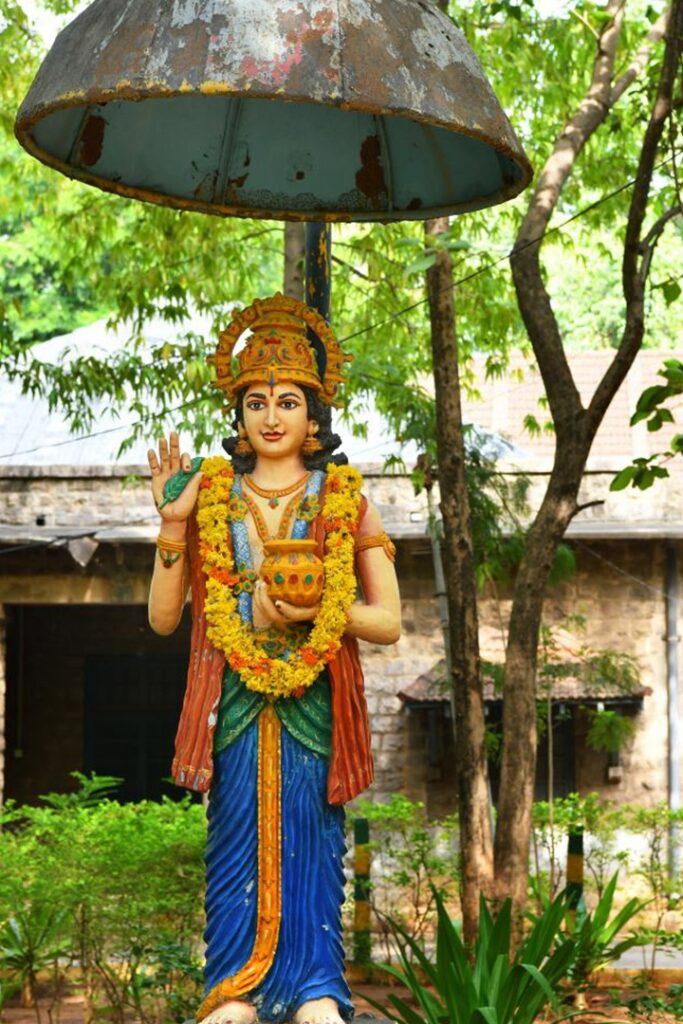
Upon witnessing Dhanvantari with the nectar jug, the demons, coveting both the container and its contents, forcibly seized it. The demigods, disheartened by this act, sought refuge at the lotus feet of the Supreme Lord, Hari. Seeing the demigods’ distress, the Supreme Lord, always eager to fulfill His devotees’ desires, assured them.
Vishnu assumes the form of Mohini Murti
The Supreme Lord Vishnu, capable of overcoming any adverse circumstance, assumed the form of an exceedingly beautiful woman known as Mohini murti. This female incarnation was incredibly pleasing to the senses. Her complexion resembled the newly bloomed blackish lotus, and every facet of her body was exquisitely arranged. Adorned with earrings that graced her equally enchanting ears, her cheeks radiated beauty, her nose was elegantly upturned, and her face exuded youthful luster. Her generous bosom created an illusion of a slender waist, while the aroma of her face and body attracted bumblebees, causing her eyes to shimmer with restlessness. Her exquisite hair was adorned with mallika flowers, her gracefully curved neck was adorned with a necklace and various ornaments, and her arms were embellished with bangles. She wore a clean sari that draped her form gracefully, and her legs were adorned with melodious ankle bells. Her shy smile and the movements of her eyebrows as she glanced at the demons stirred passionate desires within each demon, and they all yearned to possess her.
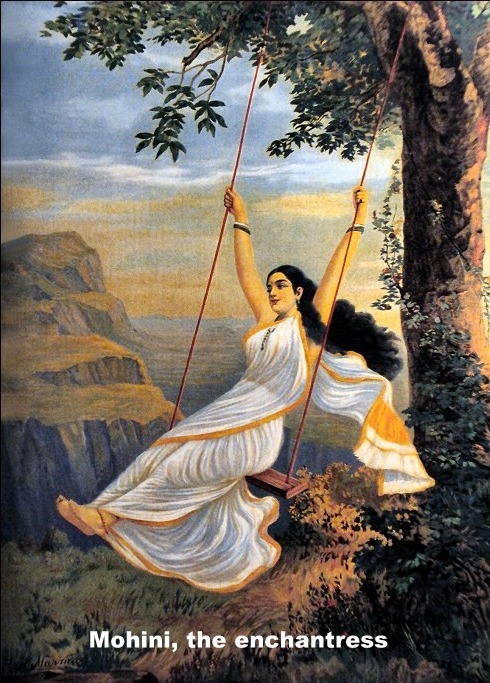
Amidst the ongoing quarrel among the demons over who would taste the nectar, they selected this captivating woman as a mediator to resolve their dispute. Exploiting their vulnerability, Mohini, the incarnation of the Supreme Lord, craftily persuaded the demons to promise they would accept her decision without objection. With this commitment in place, the enchanting Mohini arranged the demigods and demons in separate rows to distribute the nectar. She was well aware that the demons were ill-suited to consume it, so she shrewdly distributed all the nectar to the demigods. Upon realizing they had been outwitted by Mohini-murti, the demons fell silent. However, one demon, named Rahu, disguised himself as a demigod and took a seat amidst them, positioning himself next to the demigods sun and the moon. Recognizing Rahu’s deceit, the Supreme Lord swiftly severed the demon’s head. Nonetheless, since Rahu had already consumed the nectar, his decapitation did not result in his demise, and he remained alive. From that day, the demon’s head was called Rahu and his body was called Ketu.
Demons Defeated and Demigods Restored
Having granted the demigods the nectar, Lord Vishnu returned to His abode atop Garuda. However, the aggrieved demons, still nursing their grievances, once again declared war against the demigods. Bali Maharaja, the son of Virochana, assumed the role of commander-in-chief for the demon forces.
At the outset of the battle, the demigods prepared to confront the demons. Indra, the King of heaven, engaged Bali in combat, while other demigods like Vayu, Agni, and Varuna confronted other demon leaders. During the battle, the demons were initially defeated, but to escape death, they resorted to various illusory tactics, using material manipulations that resulted in the loss of many demigod soldiers.
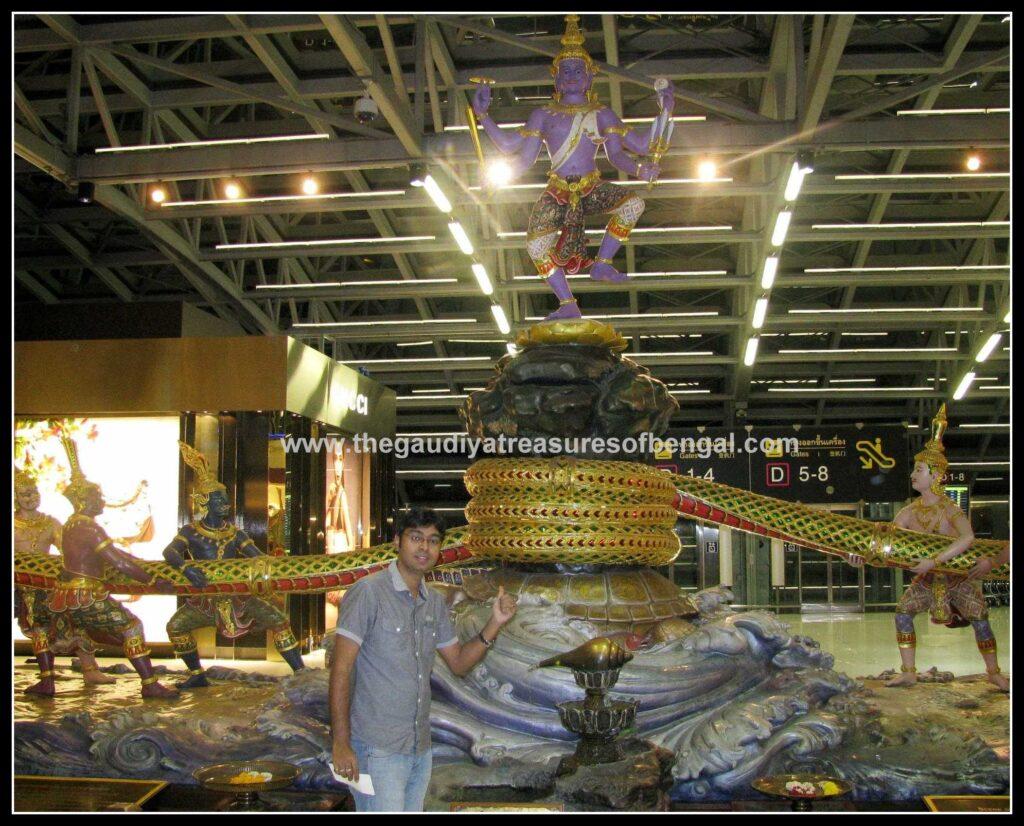
Finding no other recourse, the demigods once again turned to the Supreme Personality of Godhead, Vishnu, for aid. Vishnu promptly appeared and dispelled all the illusions created by the demon’s deceitful maneuvers. Heroic demons like Kalanemi, Mali, Sumali, and Malyavan challenged Lord Vishnu but were ultimately vanquished by His divine power. Thus, the demigods were liberated from all impending dangers. The demigods successfully re-established their authority in the celestial realms and expelled the demons to the lower planetary systems.